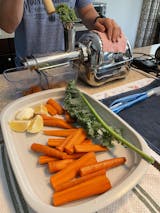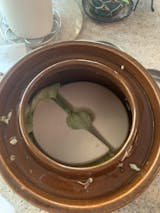Why use a food dehydrator?
Dehydrating food is one of the oldest methods of preserving food. Dehydrated foods have been used for thousands of years when fridges or freezers weren't invented, to keep it fresh and to last. Dried food is a really inexpensive way of ensuring fresh food does not get wasted and gives food an extra long shelf life.
Dehydrating foods is also a great way to lighten the load of food so that it can be carried with you and used for healthy snacks. Dehydrating food essentially means that you are removing moisture from food to around 5-20% of its original content.
What food can you dehydrate?
There are so many options in terms of dehydrating food, there are almost no limits! You could start with fruits and vegetables such as apples, bananas, peach, apricots and cherries, or meats such as beef or chicken. For those following a raw food diet, this is the perfect way to prepare food as there is no cooking in the process, dehydrating simply removes the moisture content.
There are numerous recipes available across the internet, ranging from apple chips to beef jerky, so there are plenty of options and preferred snacks or meals that can be made from dehydrated foods.
Many people also use dehydrators to dry out herbs, such as oregano or basil, which can then be stored and used for much longer than the herbs grown fresh. Additionally, a dehydrator can be used to remove moisture from tea herbs such as lemon balm and mint.
A dehydrator is also a great tool for drying non-foodstuff such as aromatic plants to be used in pot pourri!
How long does dehydrated food last?
If the process is done correctly, dehydrated food can last for long periods of up to a year. When stored correctly or in vacuum bags, dehydrated food can last for several years!
If you are not vacuuming, dry fruit or dried food should be stored in clean, dry jars or freezer containers with a tight fitted lid.

How do food dehydrators work?
A dehydrator is essentially a machine that removes moisture content from whatever is placed within it. It is made up of trays, heating elements, air vents and a fan to circulate the heat.
The food or herb is placed on trays within the dehydrator. The heating element acts as the catalyst to raise the temperature inside the machine, with the fan acting as the air circulation tool in order to remove the moisture.
Dehydrators can be set to a range of different temperatures, depending on what you are trying to dehydrate. Some foodstuffs benefit from low temperatures, whereas other produce requires a higher temperature. However, the temperatures are not designed to cook the food, they are maintained at a relatively low level in order that the moisture is removed but the vitamins and nutrients within the food remain, as well as the flavor.
The removal of moisture from food in the dehydrator ensures that mold and yeasts do not form and therefore the drying process is an ideal method of food preservation.
One of the key facets of a dehydrator is the air circulation. Without this, the moisture would linger and the produce would not dehydrate. The air circulation pushes the moisture held within the machine to the air vents which enable it to escape, which enables a moisture-free environment.
The best dehydration machines on the market ensure that the air is circulated evenly and therefore produces the best final goods.
How to use a dehydrator
Using a dehydrator is relatively straightforward. The one key element is preparation. Failure to prepare properly will leave you with poor results.
In order to get an even and quality consistency, the fruit, vegetable or meat needs to be prepared well and cut evenly. You can purchase tools that cut pieces evenly or just simply use a quality knife and try to be as accurate as possible.
Vegetables and fruits should be between 1/4 inch and 1/2 inch thick when dehydrating for the best results. Meat should be cut even thinner if possible. You certainly want to remove the fat from meat, but you may also want to remove the skin or peel from fruit and vegetables which can often house the many imperfections that you should try to remove.
Once you have prepared the fresh fruit or vegetables, carefully layer them on to the trays evenly and well spread apart and then set the machine temperature and time. This can vary significantly, dependent on what you are dehydrating, so it's best to look online for guides or even within your machine instructions.
Dehydrating fruit
It's best to use fruit that is at its most ripe when preparing them for a dehydrator. This is the point at which fruit is at its sweetest and so the dried fruit snack will taste so much better if the produce is dried at this point.
To prepare, make sure that you wash the fruit and remove any imperfections, as these can turn black when dehydrated and may not taste great. The fruit should be sliced evenly so that moisture is removed evenly. Fruits like apples and bananas can take anywhere from 6 to 16 hours to dry but apricots and grapes can take up to 36 hours. It's worth noting these drying times if you are preparing fruits for a specific purpose.
Dehydrating vegetables
Vegetables tend to dry much quicker than fruits but conversely this means they have the potential to spoil much quicker. Ensure that you keep vegetables as fresh as possible before you dehydrate them by keeping them cool for as long as possible and not preparing too much at once, so that the air gets to them and spoils them, before dehydrating.
Again, careful preparation is key. Ensure any imperfections are removed to avoid unsightly blemishes and slice the vegetables evenly. You may want to blanch the vegetables before dehydrating them to preserve as much flavor as possible. Drying times can range from 4 to 10 hours.
Dehydrating meats and fish
It's best to use lean meat when dehydrating as fat does not last well. When dehydrating meat, it's best to prepare by removing any fat or sinew and cutting into cubes of about half an inch. When drying cooked meat, allow between 6 to 12 hours to dry fully.
If you're looking to make beef jerkies, curt raw meat into fine strips. The meat will then need to be cured for 6 to 12 hours by using a salty rub or marinating in brine. After removing from the fridge, remove the rub or marinade and dehydrate until the strips crack but don't break when bent.
What is the best food dehydrator?
As with any kitchen based equipment, the best food dehydrator for you is one that is most suited to your needs. The key questions to ask are how much you are looking to spend on your dehydrator, how big you need it to be and the outcome that you desire. Most modern dehydrators are digitally based, which helps to better control the temperature and time for dehydrating.
Models such as the L’Equip FilterPro Digital Food Dehydrator have an auto shutoff timer to ensure that the dehydrator switches off at the appropriate time. Other models, such as the Tribest Sedona Express SD-6280, SD-6780 Digital Food Dehydrator, have a higher capacity, with 11 trays available for produce. Ideal if you are looking to dry food in greater quantities.
If you like to have better control over your finished goods, then the Samson "Silent" Digitally Controlled 10-Tray Stainless Steel Dehydrator has a clear glass panel through which you can observe the progress of your dehydration and an important feature to make sure that everything is going to plan.
If you're looking for a cost effective dehydrator in order to road test your creations, then a Samson Silent SB-106B Digital Dehydrator, with 6 trays is ideal. The main difference with this model is that it take up less space in your kitchen but it also has some of the excellent specifications of more expensive models - perfect for beginners!

What are the best tips and tricks to use to dehydrate food?
Dehydrating food can often be a case of trial and error, but here are some key tips that should help to make your dehydrating adventure a success!:
- Make sure that you use the freshest, cleanest food or other produce that you can. Starting with poor produce will ultimately produce poor results.
- Try to cut all your produce into uniform pieces. This ensures that the drying is even and the end product is evenly dehydrated.
- Ensure that your vegetables, fruits, meats or herbs are arranged in a single layer. This again encourages even dehydration.
- Keep checking on your food. Because the process is so slow, you are able to check the output at various intervals.
- Test smaller amounts. A good test to see if the dehydration has been sufficient is to place some finished goods in a sealed mason jar or similar - if the jar fogs up then there is still too much moisture content.
- Don't dry things too quickly. Much like when using an oven, if you cook things at a really high temperature, then they often appear cooked on the outside but raw on the inside. With dehydration, the product may look like it has been sealed, but may contain moisture within, meaning it will spoil quickly.
- Make sure that you are efficient. Warm the dehydrator up to the sufficient temperature and dry items that require similar temperatures and cycles at the same time.
In summary, dehydrating food requires patience, but the rewards are certainly worth it. With food prices increasing significantly, dehydrating is a great way to ensure that food does not get wasted and can be enjoyed at its nutritional optimum.
If you are looking for a dehydrator to experiment with or you are passionate about dehydrating food, then Extreme Wellness Supply has an extensive range of dehydrators to suit all budgets and needs.























